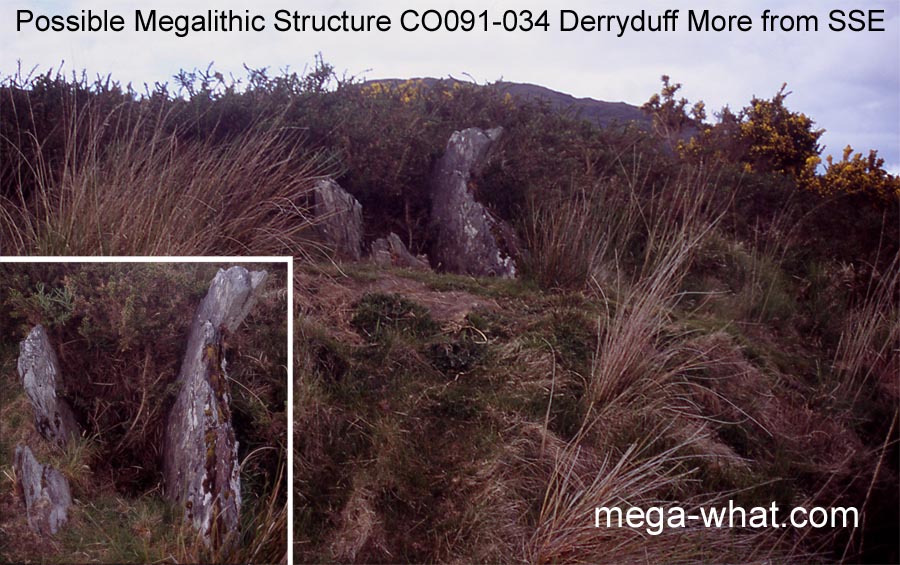 Derryduff More Possible Megalithic Structure is in Coomhola, about 6km from Ballylicky. Horizon survey indicates that this very probably is a megalithic site.
From its structure it would appear to be related to the wedge tomb culture.
A small percentage of monuments of types normally oriented on a NE/SW axis have extreme orientations, beyond the lunar limits. This one is oriented a little east of south.
Derryduff More Possible Megalithic Structure is in Coomhola, about 6km from Ballylicky. Horizon survey indicates that this very probably is a megalithic site.
From its structure it would appear to be related to the wedge tomb culture.
A small percentage of monuments of types normally oriented on a NE/SW axis have extreme orientations, beyond the lunar limits. This one is oriented a little east of south.
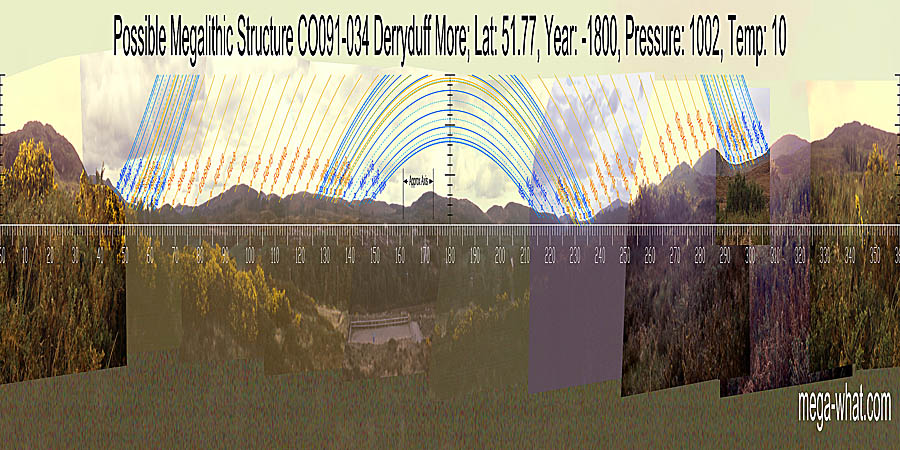 South is marked by the central top of a hill [Pic].
South is marked by the central top of a hill [Pic].
North is in the central dip of a hilltop [Pic].
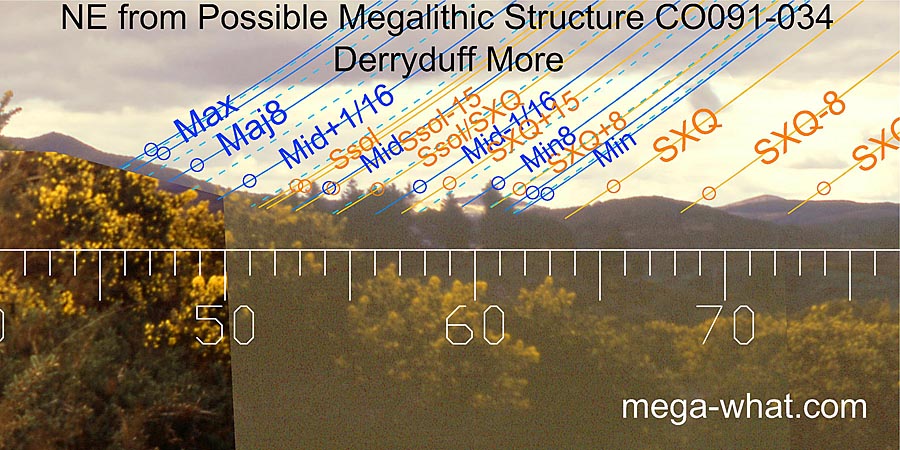 To the north-east, the minor standstillLunistice positions vary cyclically over an 18.6 year period but are fairly static for more than a year at either end of the range
occurs just above the southern foot of a distant hill which has the lunar minor eighth of the lunisticeLunistices are the most northerly and southerly moons of the month. The lunar equivalent of solstices - more.
range on its top.
North of this, the rest of the cycle runs down into a dip and up a rocky ridge. Lunar extreme, major eighth and sixteenth are all at breaks in the upper slope.
The dip, and most of the northern end of the solar cycle is currently obscured by nearby trees.
To the north-east, the minor standstillLunistice positions vary cyclically over an 18.6 year period but are fairly static for more than a year at either end of the range
occurs just above the southern foot of a distant hill which has the lunar minor eighth of the lunisticeLunistices are the most northerly and southerly moons of the month. The lunar equivalent of solstices - more.
range on its top.
North of this, the rest of the cycle runs down into a dip and up a rocky ridge. Lunar extreme, major eighth and sixteenth are all at breaks in the upper slope.
The dip, and most of the northern end of the solar cycle is currently obscured by nearby trees.
 The summer cross-quarter occurs at an obvious break halfway up a hillslope and the equinox is on a hilltop.
The midpoint in time between them is in the dip between them, emphasised by the top of a nearer hill.
South of the equinox, its half-month bracket rises up the slope from a dip to a minor top. The winter cross-quarters are on a hilltop.
The summer cross-quarter occurs at an obvious break halfway up a hillslope and the equinox is on a hilltop.
The midpoint in time between them is in the dip between them, emphasised by the top of a nearer hill.
South of the equinox, its half-month bracket rises up the slope from a dip to a minor top. The winter cross-quarters are on a hilltop.
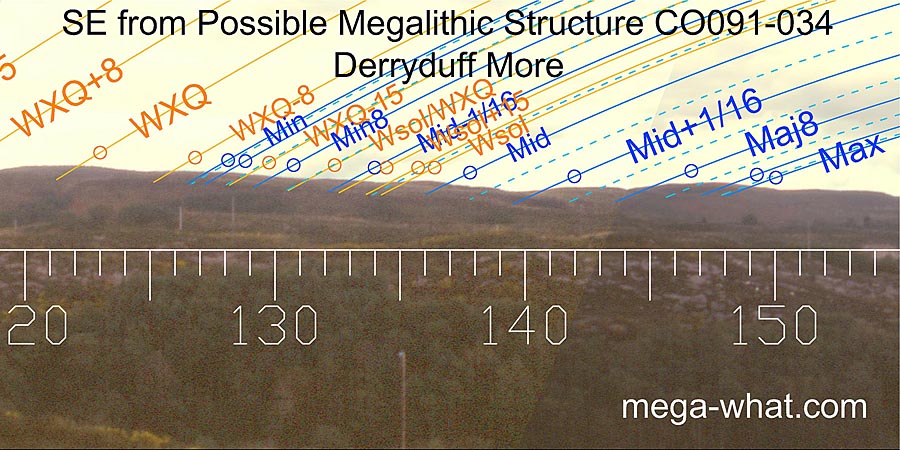 The south-eastern horizon is the opposite side of the valley and it runs in a series of gentle undulations that are well matched to the divisions of the solar and
lunisticeLunistices are the most northerly and southerly moons of the month. The lunar equivalent of solstices - more.
cycles.
The south-eastern horizon is the opposite side of the valley and it runs in a series of gentle undulations that are well matched to the divisions of the solar and
lunisticeLunistices are the most northerly and southerly moons of the month. The lunar equivalent of solstices - more.
cycles.
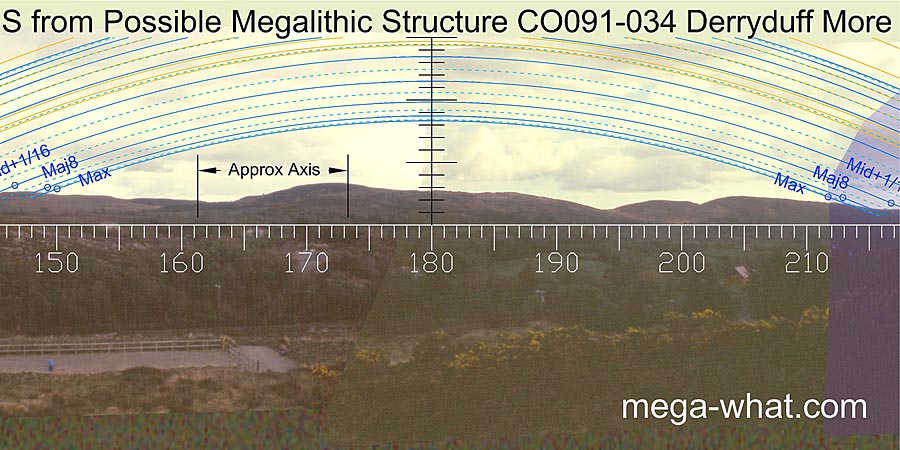 Due south is marked by the centre of a hill, not its highest point.
The tomb axis is towards the eastern side of the hill, giving declinations around -34.8 which, though marking the most southerly stars of Scorpio and Sagittarius, is not otherwise significant.
Due south is marked by the centre of a hill, not its highest point.
The tomb axis is towards the eastern side of the hill, giving declinations around -34.8 which, though marking the most southerly stars of Scorpio and Sagittarius, is not otherwise significant.
 To the south-west, the major end of the lunisticeLunistices are the most northerly and southerly moons of the month. The lunar equivalent of solstices - more.
range falls over a step like series of breaks and the slope at the end of the ridge is a sixteenth.
Beyond that, a prominent distant hill is notable for the way the winter solstice and lunar midpoint fall on it.
Then we are on nearer ground again and the minor end of the lunisticeLunistices are the most northerly and southerly moons of the month. The lunar equivalent of solstices - more.
cycle is marked by a break at the foot of a hillslope.
To the south-west, the major end of the lunisticeLunistices are the most northerly and southerly moons of the month. The lunar equivalent of solstices - more.
range falls over a step like series of breaks and the slope at the end of the ridge is a sixteenth.
Beyond that, a prominent distant hill is notable for the way the winter solstice and lunar midpoint fall on it.
Then we are on nearer ground again and the minor end of the lunisticeLunistices are the most northerly and southerly moons of the month. The lunar equivalent of solstices - more.
cycle is marked by a break at the foot of a hillslope.
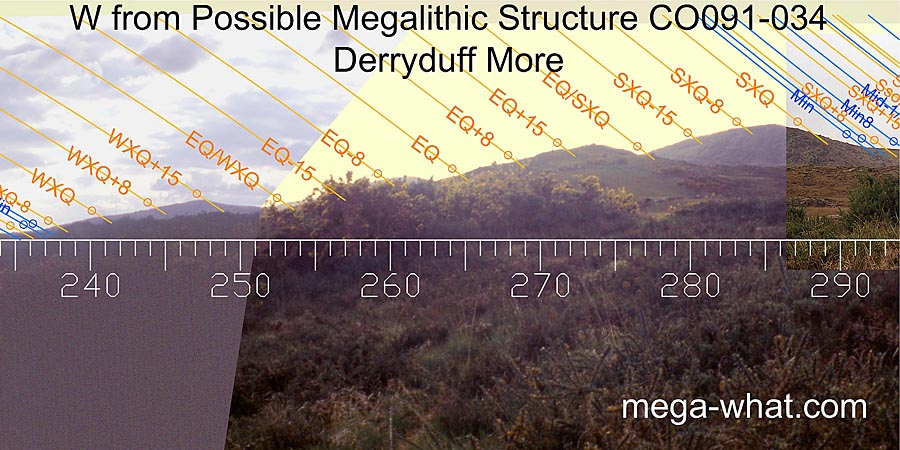 The western horizon is not exactly first class but a hilltop is a half-month north of the winter cross-quarter and
a significant intersect notch is the halfway point between equinox and summer cross-quarter.
The western horizon is not exactly first class but a hilltop is a half-month north of the winter cross-quarter and
a significant intersect notch is the halfway point between equinox and summer cross-quarter.
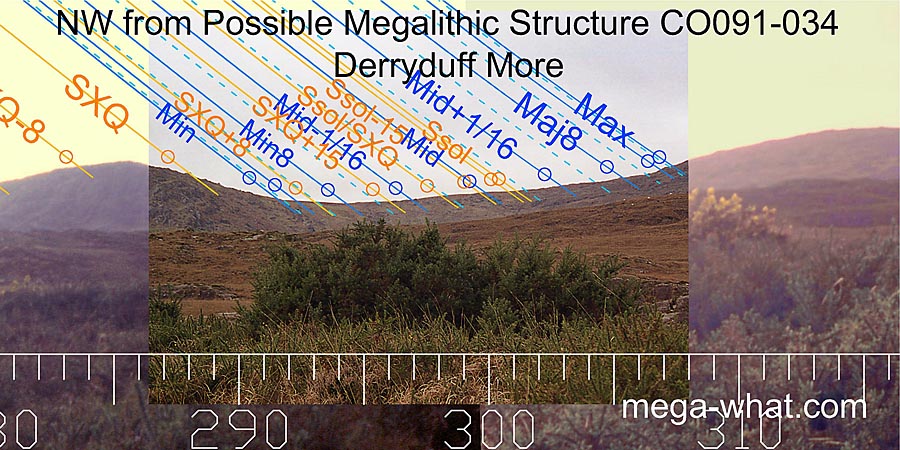 North-westwards, the crucial zone from cross-quarter to lunar maximum is spread across a rocky saddle. The cross-quarter itself falls exactly on a very prominent pointed rock outcrop.
The minor end of the lunisticeLunistices are the most northerly and southerly moons of the month. The lunar equivalent of solstices - more.
range is in the notch at the foot of the slope and the lunar minor eighth at the bottom of the dip.
As the slope rises again, various features are available as markers and the resolution of the photograph does not do them justice.
North-westwards, the crucial zone from cross-quarter to lunar maximum is spread across a rocky saddle. The cross-quarter itself falls exactly on a very prominent pointed rock outcrop.
The minor end of the lunisticeLunistices are the most northerly and southerly moons of the month. The lunar equivalent of solstices - more.
range is in the notch at the foot of the slope and the lunar minor eighth at the bottom of the dip.
As the slope rises again, various features are available as markers and the resolution of the photograph does not do them justice.
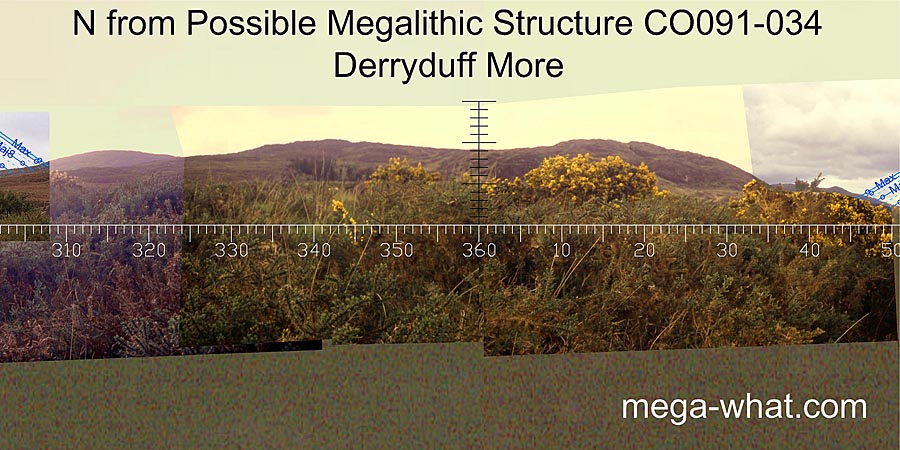 Due north is roughly marked by a saddle.
The axis of the tomb is of no apparent significance, neither is there any obvious pattern to the general run of the northern horizon other than a rough symmetry around the north point.
Between due north and major standstillLunistice positions vary cyclically over an 18.6 year period but are fairly static for more than a year at either end of the range
of the moon, to both east and west, there is a hilltop then an intersect notch and a second hilltop.
Due north is roughly marked by a saddle.
The axis of the tomb is of no apparent significance, neither is there any obvious pattern to the general run of the northern horizon other than a rough symmetry around the north point.
Between due north and major standstillLunistice positions vary cyclically over an 18.6 year period but are fairly static for more than a year at either end of the range
of the moon, to both east and west, there is a hilltop then an intersect notch and a second hilltop.
- Derreengreanagh Wedge Tomb is c.11km south (186°)
- Island Wedge Tomb is c.70km north-east
References
- Archaeological Survey of Ireland, record details. www.archaeology.ie/archaeological-survey-ireland
- RONAN, S. et al. 2009 Archaeological Inventory of County Cork, Volume 5. Dublin: Stationary Office. p119, no 16016.
